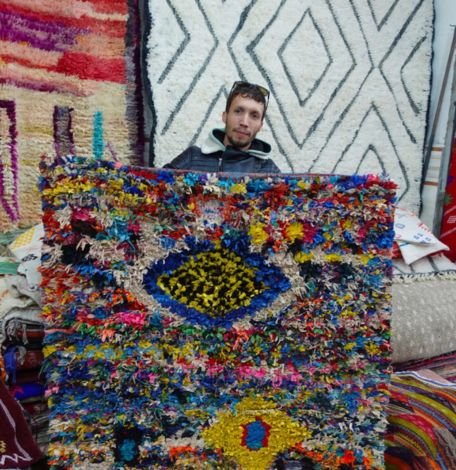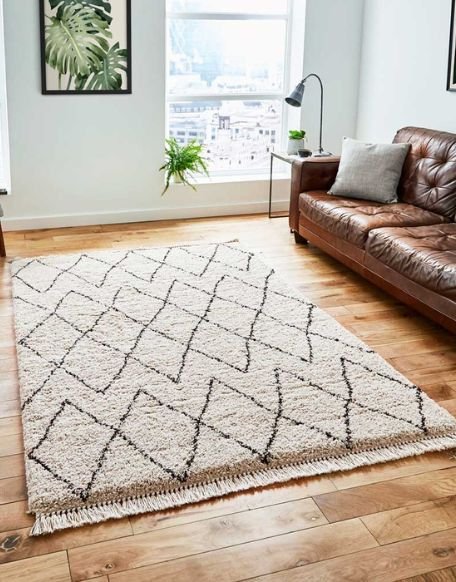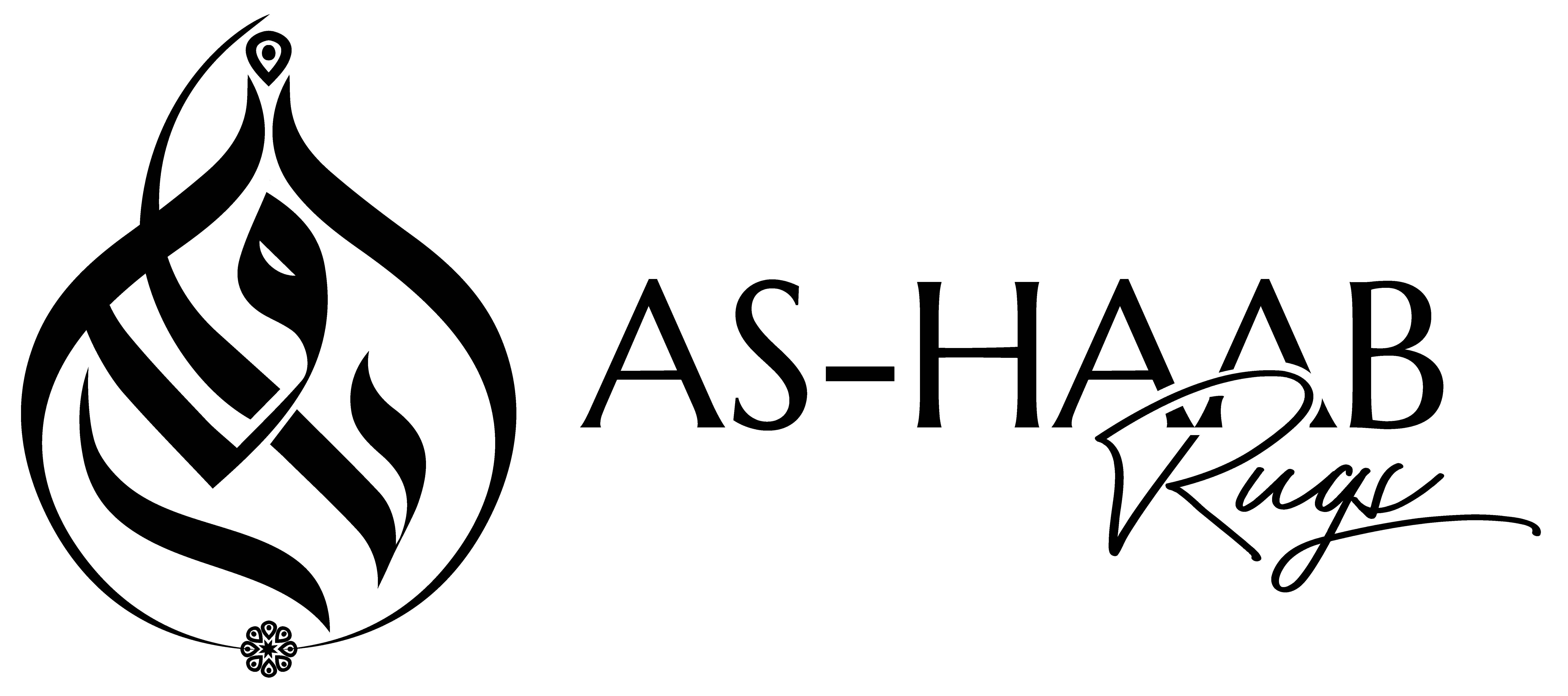
The Beauty Within Moroccan Berber Rugs | History, Styles, and Care Tips
Moroccan Berber rugs, known for their well-made beauty and high pile, have amazed people around the world for centuries. These hand-woven rugs are not just floor coverings; they are pieces of art that tell a story of the rich Berber culture and heritage. Originating from the indigenous tribes of the Atlas Mountains in Morocco, these rugs have become a symbol of warmth, tradition, and craftsmanship.

Whether you’re looking to add a touch of exotic charm to your home or simply appreciate the craftsmanship behind these stunning pieces, exploring the world of Moroccan shag rugs will be a rewarding experience.
History and Origins of Moroccan Berber Rugs
Moroccan Berber rugs have a rich history that dates back centuries and are an integral part of Berber culture in North Africa. These rugs are handwoven by Berber tribes, primarily women, and each rug tells a unique story through its design, symbols, and patterns.

The Berber people, indigenous to North Africa, specifically the Atlas Mountains and regions across Morocco, Algeria, Tunisia, Libya, and Mauritania, have a long tradition of weaving rugs. Although, the term “Berber” refers to various ethnic groups with their languages, customs, and traditions, and the rugs themselves are often named after the tribes or regions where they originate.
The tribes crafted these rugs using materials straight from their surroundings. They relied on the wool from their sheep and extracted dyes from nearby plants and minerals to infuse vibrant colors into their creations. Beyond their practicality, Berber rugs served diverse roles within the Berber communities. They weren’t just floor coverings; they doubled as cozy blankets, adding warmth during colder times. Moreover, they adorned ceremonial events and festive celebrations, becoming an integral part of the cultural tapestry, weaving stories and traditions into their intricate patterns.
In recent years, the demand for handmade Moroccan Berber rugs, including those with influences from mid-century modern rugs, has increased globally, leading to preservation efforts to protect traditional weaving techniques and adaptations to cater to modern tastes and preferences. However, traditional artisans continue to weave rugs using age-old methods, keeping alive the heritage and artistry of Berber rug making.
Traditional Styles and Materials
Moroccan Berber carpets come in a variety of styles and designs, much like the diverse array of electronics found at Hafeez Center online store. One of the most well-known styles is the Beni Ourain Moroccan rug, which originates from the Atlas Mountains. These rugs are characterized by their plush, shaggy pile and simple geometric designs in neutral tones. Beni Ourain rugs are highly sought after for their timeless appeal and ability to seamlessly blend into any interior design scheme.
Another popular style is the Azilal Moroccan rug, which features vibrant colors and intricate patterns. These rugs are often adorned with abstract designs and symbols that hold deep meaning within the Berber community. However, Azilal rugs are a true testament to the weaver’s artistic skills and their ability to create visually stunning pieces.
In terms of materials, authentic Moroccan Berber rugs are predominantly made from wool sourced from local sheep. The wool is hand-spuned and dyed using natural pigments, resulting in a soft and luxurious texture. Nonetheless, the use of natural materials not only adds to the authenticity of these rugs but also makes them environmentally friendly and sustainable.
Care and Maintenance Tips for Moroccan Berber Rugs
To ensure the longevity and beauty of your Moroccan Berber carpet, proper care and maintenance are essential. Here are some tips to help you keep your rug looking its best:

- Regular Vacuuming: Vacuum your handmade rug regularly to remove any loose dirt or debris. Use a brush attachment or a vacuum cleaner with adjustable suction to avoid damaging the delicate fibers.
- Spot Cleaning: In case of spills or stains, act quickly to prevent them from setting into the fibers. Blot the affected area with a clean, dry cloth and avoid rubbing, as this can spread the stain further. Besides, for stubborn stains, consult a professional rug cleaner.
- Rotate Your Rug: Additionally, to ensure even wear, rotate your rug every few months. This will help prevent certain areas from becoming more worn out than others.
- Avoid Direct Sunlight: Moreover, exposure to direct sunlight can cause the colors of your rug to fade over time. If possible, place your rug in an area with minimal sunlight or use window treatments to protect it.
- Professional Cleaning: Every few years, consider having your Moroccan Berber rug professionally cleaned. This will help remove deep-seated dirt and restore the rug’s original vibrancy.
By following these care tips, you can enjoy the authenticity of your Moroccan Berber wool rug for years to come.
Ready for more insights on choosing the perfect rug? Explore our blog on “12 Tips for Choosing a Hallway Runner” for further inspiration and guidance!
Decorating Ideas and Inspiration with Moroccan Berber Rugs
Moroccan Berber carpets are incredibly versatile, seamlessly blending into various interior design styles. Whether you lean towards bohemian, minimalist, or eclectic aesthetics, these rugs effortlessly enhance the ambiance of any space. They bring a unique charm, adding depth and character to your interior design, no matter your preferred style. Here are some decorating ideas and inspiration to help you incorporate Moroccan Berber style rugs into your home:
- Layered Look – Create visual interest by layering your Moroccan Berber rug over a larger neutral-colored rug. This adds depth and texture to your space while allowing the intricate patterns of the Berber rug to shine.
- Statement Piece – Make your Moroccan Berber rug the focal point of your room by placing it in a prominent area, such as placing the center of your living room or under a dining table. Allow the rug to take center stage by keeping the surrounding furniture and décor simple and understated.
- Mix and Match – Embrace the eclectic charm of Moroccan rugs by mixing them with other patterns and textures. Pair a vibrant Afghan rugwith bold or mix different styles of rugs for a unique and visually captivating look.
- Bohemian Oasis – Create a cozy bohemian retreat by layering Moroccan Berber carpets with floor cushions, poufs, and plenty of cozy Kilims. Add plants and natural elements to complete the relaxed and earthy vibe.
- Modern Minimalism – Contrary to popular belief, Moroccan Berber rugs can also complement a modern minimalist aesthetic. Opt for a vintage Moroccan Berber rug and pair it with sleek, clean-lined furniture for a minimalist look with a touch of warmth and texture.

Remember, when it comes to decorating with Berber rugs, there are no hard and fast rules. Let your creativity guide you and have fun experimenting with different styles and combinations.
Conclusion
To sum up, Moroccan Berber rugs transcend mere floor coverings; they embody art, history, and culture. Every rug’s creation involves meticulous craftsmanship and an eye for detail, rendering each piece truly distinctive and enthralling. Whether opting for a modern Berber rug exuding subtle sophistication or an Azilal Berber rug pulsating with vibrant energy, incorporating a Moroccan Berber rug into your living space guarantees an infusion of coziness, personality, and an exotic allure. When handled with care and maintained diligently, these rugs become heirlooms, carrying forward the timeless allure inherent in Moroccan Berber heritage, resonating through generations as a testament to its enduring splendor.
So, why wait? Discover the unique stories woven into each rug—explore the captivating collections at As-haab Rugs today and invite the beauty of rugs into your home.
